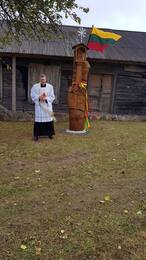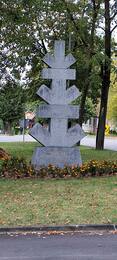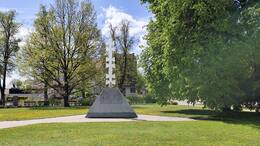A fateful meeting in a bunker: the 1949 Congress of Lithuanian Partisan Commanders
On February 10-20, 1949, the only congress of partisan commanders in occupied Lithuania took place in the Mikniai farmstead bunker in the Minaičiai village of Radviliškis district, during which the Lithuanian Freedom Struggle Movement (LLKS) was founded and the Declaration of Independence was proclaimed.
"This is a great, long-desired victory, achieved through blood sacrifice and hardship," - these are the words with which the partisan leaders announced this historic event to their comrades. In a six-square-meter bunker, the height of which was no more than 1.50 cm, eight freedom fighters deliberated for ten days about the future of Lithuania.
The journey to the congress was particularly difficult. As A. Ramanauskas-Vanagas testifies in his interrogation protocol: "I agreed with Faustus that we would go to Samogitia together: he as a representative of the Tauras district, I as a representative of the Dainava district. [...] With great difficulty we walked from one partisan formation to another..." Due to the winter and the heavy snowfall, the partisans had to walk "one after the other like geese, so that it would seem that one person was walking."
The congress adopted the Declaration of the Lithuanian Communist Party, which can be considered a temporary Constitution of occupied Lithuania. As partisan Bronė Morkūnienė-Žilvitė recalls: "There was a strong guard. Maybe two hundred men or more - the forest was full. If there had been fighting there, a real front would have opened."
The scale of the partisan struggle and sacrifice is reflected in the diary entry of partisan Lionginas Baliukevičius-Dzūkas: "Lithuanian Freedom Movement in all of Lithuania! At any cost!... I feel scared when I remember that long, long line of those who died..."
Of the eight signatories of the declaration, half were teachers, two were students, one was an officer, and one was an accountant. Three of them died that same year, three more a year or two later, and two were shot. The document they left behind became part of the chain of three major acts of Lithuanian independence (1918, 1949, and 1990).
Related timeline
Related topics
Related objects
Sąjūdis Memorial to Lithuanian Freedom Fighters in Minaičiai (Minaičiai Bunker-Museum)
In the autumn of 1948, the farm of partisan supporters A. and S. Mikniai in the village of Minaičiai (Radviliškis district) was chosen as the wintering place for the Prisikėlimo Military District headquarters. The partisans dug a small bunker under the barn to house the staff of the district.
On 16 February 1949, the partisan commanders in Minaičiai finalised and published the declaration of the Lithuanian freedom struggle “Sąjūdis”. The main aim of the Declaration was to restore Lithuania to a parliamentary republic (as it was from 1920–1926). Eight people formally attended the meetings: Jonas Žemaitis- Vytautas, Juozas Šibaila-Merainis, Petras Bartkus-Žadgaila, Adolfas Ramanauskas-Vanagas, Aleksandras Gribinas-Faustas, Vytautas Gužas-Kardas, Leonardas Grigonis-Užpalis, and Bronius Liesys-Naktis.
The bunker was also used later. A partisan pharmacist Izabelė Vilimaitė-Stirna treated partisan Laurynas Mingilas-Džiugas, who was seriously wounded in the Battle of Užpelkiai. In 1953, the unoccupied bunker caved in and the owners earth-filled it.
In 2010, the work on the restoration of the partisan bunker and barn, as well as the construction of the monument began. The monument, created by sculptor Jonas Jagėla, bears the names of the partisans who signed the Declaration. An authentic, glassroofed partisan bunker has been built in the barn, and the visitors are provided an opportunity to see it from above; there is also an exhibition in the barn.
Partisan liaison officer's homestead in Saiai
The homestead of the partisan supporters of the Sajės in Balandiškis, Grinkiškis eldership, Radviliškis district, is connected with the struggles for freedom in Lithuania. Its history is usually presented together with the Mikniai homestead, located in nearby Minaičiai (Lithuanian Freedom Movement Memorial).
This secluded and modest homestead, according to the recollections of Viktoras Šniuolis-Vitvytis, an eyewitness to the events, and confirmed by some research, was the place where the founding documents of the Lithuanian Freedom Struggle Movement (LLKS) were probably prepared. The LLKS became the most important organization of resistance to the Soviet occupation, covering the entire territory of Lithuania. It is reported that since 1946, freedom fighters had been visiting this homestead to rest and gain strength. After the partisan liaisons held a congress of partisan commanders at the Mikniai homestead in February 1949, the headquarters of the LLKS Public Division operated at the Sajai homestead (in a bunker installed in a barn), and the LLKS periodical, the newspaper "Prie rymancių rūpintojėlio", was published.
Partisans visited the bunker of the Sajai homestead many times, wintered there, or were treated for injuries. The hearth of freedom at the Sajai homestead existed until 1952. In the autumn of that year, the bunker was discovered, and the owners of the homestead were arrested.
Currently, the homestead is almost completely dilapidated, but it contains a monument, an information stand, and a chapel pillar to commemorate important historical events that took place at this location.
Monument to the partisans of the Resurrection District in Šeduva
On October 14, a monument to the partisans of the Resurrection District was unveiled in Šeduva Laisvės Square. The authors of the monument: sculptor Romanas Kazlauskas, architects Arūnas Eduardas Paslaitis and Viktorija Paslaitytė. It is a joint work of the Lithuanian Genocide and Resistance Research Center (LGGRTC) and the Radviliškis District Municipality.
Monument to the Partisans of the Resurrection District, commemorating all Lithuanian partisans who fought and died in this district in 1944-1953.
This is another monument dedicated to the memory of the Lithuanian partisan districts. The following districts have already been immortalized: Algimantas – Troškūnai, Anykščiai district, Didžioji Kova – Gelvonai, Širvintos district, Tauras – Marijampolė, Žemaičiai – Telšiai and Vytis – Vadokliai, Panevėžys district.
Monument to Bronislovas Liesis-Nakčiai
In the center of the city of Ramygala, Panevėžys district, on Laisvės Square, in the historical part of the city, stands a monument designed by Jonas Jurgėla (architects Algis Vyšniūnas, Robertas Bardauskas).
A monument dedicated to the memory of Bronislovas Liesis – Nakčia, a signatory of the Declaration of the Council of the Lithuanian Freedom Struggle Movement of February 16, 1949.
B. Liesis and his twin brother Antanas were born in 1922 to the family of the director of the Ramygala Junior High School in Panevėžys County. Their parents were deported to Siberia in 1941, where they died.
During the Nazi occupation, B. Liesis belonged to the Lithuanian Freedom Defenders Union. In 1944, together with his brother, he went to a German military intelligence school on the orders of the Lithuanian Freedom Army, where he studied partisan warfare tactics. On December 21, 1944, he was landed in the forests of Kėdainiai County. Both Liesis reached the Jurbarkas area, and from the beginning of 1945 they fought in the Lydis partisan detachment. From 1948, B. Liesis headed the Prisikėlimos district, edited the newspaper "Prisikėlimos ugnis", and wrote poems under the pseudonym Ēglis. His work was published in the collection "Kovos keliu žengiant" (Walking the Path of Struggle), as well as in the partisan press.
In February 1949, in a bunker set up in the Minaičiai farmstead in Radviliškis district, B. Liesis, together with other representatives of Lithuanian partisan districts, participated in the Congress of Lithuanian partisan commanders, which announced the establishment of a unified resistance organization - the Lithuanian Freedom Struggle Movement. On February 16, the Declaration of the Council of the Lithuanian Freedom Struggle Movement was adopted. At the congress, B. Liesis was appointed a member of the Presidium of the Council of the Lithuanian Freedom Struggle Movement, and he was awarded the rank of freedom fighter partisan captain.
Bronislovas died on August 13, 1949, in a partisan camp set up in the Užpelkiai forest of Grinkiškis parish, Radviliškis county, during battles with MGB soldiers.
Monument to the Partisans of Vytautas County
In Utena, a monument to the partisans of Vytautas County was erected in Utena Square in 2009. The monument symbolizes an altar, and its authors are sculptor Vidmantas Gylikis and architect Marius Morkūnas. It is dedicated to the memory of the partisan fighters of the three Vytautas County teams.
The partisans relied on three fundamental things in life: Faith, Hope and Love – for God, Homeland, neighbor... The number "three" is repeated in various forms in the composition. The three planes of the pyramid are the three partisan teams, the fourth is our land on which we live... From half of the pyramid, as if from the fog, a forest of crosses emerges, symbolizing our brothers and sisters who sacrificed their lives on the Altar of Freedom, above which rises the Vytis Cross, a symbol of the nation's struggle and rebirth.








